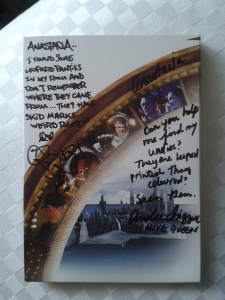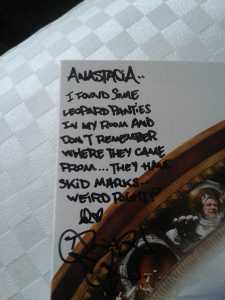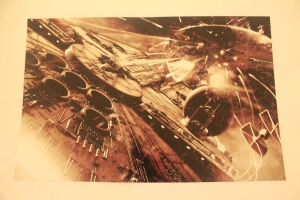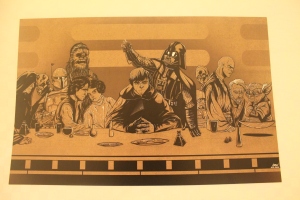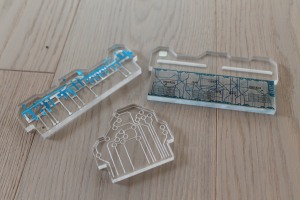Category Archives: Fandom Studies
A Much-Needed Update
As has often been the case, it’s been a while since my most recent update. With the obvious apologies offered, I have a few blog-related announcements.
The first of these is that I’m slightly expanding the focus of this blog. You may have noticed the changed “mission statement” over on the right. While this blog has primarily focused on TV shows and the ideas behind them, I hope to expand it to explorations of science fiction and geekiness in every form. There will be more convention reports, write-ups of interesting panels with thoughts relating to sci-fi, science and technology, and geek culture, and posts about geeky travel. I’ll be focusing more on the way that media and sci-fi not only reflect our world, but predict and shape it. In short, I’ll be looking far beyond the TV screen. Science fiction, media, and fandom (or geekdom) – and their intersections, in all of their possible incarnations – will be the focus.
With that said, I have a few exciting announcements about some real-world projects I’ll be engaging in – and of course, reporting on here.
is that I’ll be a panelist at the upcoming Star Trek: Mission NYC Convention from September 2-4. I’ll be on two panels: Literature and Star Trek with the lovely Amy Imerhoff on Friday at 3pm, and a panel on the Impact of Star Trek on Sunday at 4pm with Devra Langsam and Stuart Hellinger (Organizers of the first-ever Star Trek convention), Keith R.A. DeCandido, and Robert Kaul. The convention is also packed with other panels, guest appearances, set replicas, and many other fun opportunities, so of course I’ll be writing a convention report (or several), touching in particular on the interesting and intellectually stimulating ideas I come in contact with.
And, since it’s Star Trek’s 50th anniversary, one convention is obviously not enough, so I’ll also be attending Creation Entertainment’s Star Trek convention in Cherry Hill this weekend. This one promises to be less “intellectual,” with fewer panels and more guest Q&A’s, but I still plan to faithfully report on the happenings.
And, of course, as always, there’s a number of other conventions and Sherlockian events on my plate – how could there not be?
I’ve also been given the amazing opportunity to be the head of Media Programming at Philcon – the Philadelphia Science Fiction Conference, at which I’ve been a panelist for the past two years. This is the oldest literary sci-fi conference in the U.S., and it’s an honor to be part of putting it together. I’ll be writing more in the coming months about the process of making a convention happens, as well as reporting on the panels post-conference.
In the meantime, I hope to keep updating with lots of convention reports, TV show commentary, geekdom issues, and thoughts on science fiction and science fact. Stay tuned!
BSI Weekend 2016: Historical Nostalgia, Anachronism, and Modernity
(Part 1 of my BSI Weekend 2016 write-up)
Last week, I attended, for the third time, what as referred to as the “Baker Street Irregulars Weekend,” though it’s really more like a week, lasting from Wednesday to Sunday. I’ve been meaning to write a post about my experiences attending one of these for several years now, but I think this year is about the right time to do it: my first two years, I was by far too starry-eyed to say anything coherent.
The reason I was so starry-eyed is because the Baker Street Irregulars is the primary Sherlock Holmes society in the world, started in the 1930s by author and publisher Christopher Morley. It has a long and illustrious tradition, and has influenced very much of Sherlockiana and the perception of Sherlock Holmes today. I would use the word “fandom” but it goes beyond that: the Baker Street Irregulars are a way of life, and almost an ideology. As a society, they are dedicated to the study of the Sherlock Holmes stories, referred to as “the Canon,” and membership is by-invitation only. Every year, they hold a dinner (similarly by invitation only) in New York City on January 6th, Sherlock Holmes’ birthday (which is not actually in the stories; in fact, there is nothing in the stories to suggest that it’s on January 6th. The reason we celebrate it on January 6th is because in The Sign of Four, Holmes and Watson are hungover on January 7th). However, though the dinner requires an invite, the rest of the week(end) is a full schedule of events that anyone can attend, and Sherlockians the world over convene in New York to celebrate the great detective – whom we call The Master.
This year has been a landmark BSI year for me, as I was invited to the BSI dinner for the first time (I’m not yet a member of the society itself, but one can hope). In keeping with the tradition of the event, which is meant to be secretive, mysterious, and even esoteric – and cannot be audio or video-taped – I will honor the intentions behind this grand event and won’t dwell too much on describing its details.
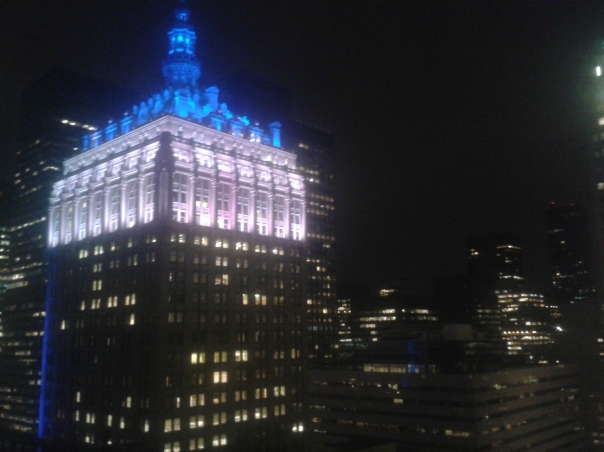
The view from the top of the Yale Club, where the dinner was held – a detail I think I’m allowed to share!
I can, however, say that the best description I’ve been able to come up with for the Baker Street Irregulars dinner is that it’s the annual get-together of a by-invitation-only literary society dedicated to the study of a fictional character, whom we pretend is real, and whose life and career was described in a series of texts we refer to as the Sacred Writings. Members are “invested” into the society on a mysterious basis using “investitures” that are phrases from the Canon – essentially, code names.
And when I put it like that, we do sound a bit insane. Which is quite all right, really.
In fact, I want to use this post to reflect on the culture of Sherlockiana – its beauty, and yet its irony. I have written, time and again, about the way that Sherlock Holmes is ultimately a highly modern figure, using the latest forms of technology, and representing secularism, reason, urbanization, industrialization – all those nineteenth century transformations. And yet the popular perception of him is so often nostalgic and anachronistic, of a Victorian figure in a deerstalker, back when there was fog and gas lamps and fireplaces and tea time in good old England. It’s a myth, and a romantic one, however inaccurate it is. However, it is not just the popular imagination that likes to associate Holmes with good old England – it is also Sherlockian culture that does it, however anachronistic it may seem. In fact, I would hazard a guess that much of this myth was constructed and propagated by the Baker Street Irregulars, many of whom were highly influential writers, actors, executives, lawyers, and politicians, among others, and who helped spread this myth.
In the early days of the BSI, Edgar W. Smith, the founder of the Baker Street Journal, referred to Sherlock Holmes as a “Galahad” from a time of Arthurian mythology and, in the first issue of the Journal, celebrated that very fog and gas lamps. G.K. Chesterton spoke of the stories as fairly tales, and Vincent Starrett, a Chicago man of letters, wrote the poem 221B, which is the best, most beautiful, and most poignant rendition of the myth and magic of Sherlock Holmes I’ve read, and these hallowed words are repeated at the end of every Sherlockian society meeting, including the BSI dinner:
Here dwell together still two men of note
Who never lived and so can never die:
How very near they seem, yet how remote
That age before the world went all awry.
But still the game’s afoot for those with ears
Attuned to catch the distant view-halloo:
England is England yet, for all our fears—
Only those things the heart believes are true.A yellow fog swirls past the window-pane
As night descends upon this fabled street:
A lonely hansom splashes through the rain,
The ghostly gas lamps fail at twenty feet.
Here, though the world explode, these two survive,
And it is always eighteen ninety-five.
It’s also, obviously, completely anachronistic- but, as the poem itself says, “only those things the heart believes are true. And there’s a reason that, despite the lack of these historical trappings in the Canon, this is what we cling to. As historian Michael Saler notes in the excellent book As IF, the BSI, as well as much of Sherockian scholarship, came into being around the time of the Great Depression and continued through into WWII and the Cold War. And in those trying times, Sherlock Holmes lived in a nostalgic and idealized version of 1895 to which these people could return.
And yet, though it’s the 21st century, that escapism is alive. The irony of this anachronistic “antiquarianism” had puzzled me for many years, as I was surprised that the careful scholars and devotees of the Canon, who knew how modern a figure Sherlock Holmes was, indulge in this nostalgically inaccurate romanticizing. But this year, attending the BSI dinner, and examining the practices of the BSI (many of which date back to the 1930s and really haven’t changed), I think I’ve come to understand why they have been preserved the way they have.
Every epoch has its escapism, of course – we have our own fair share of modern political events that we want to flee from into the comforting rooms of Baker Street. But I also think it has much to do not only with escapism, but with enchantment. As the aforementioned Michael Saler points out in his book, the late nineteenth century was perceived by many (including the sociologist Weber, who theorized it) to be a period of disenchantment due to the march of technology and progress. But Sherlock Holmes, as Saler points out, re-enchanted modernity, finding the romance in reason, the mystery in the quotidian, the magical in the commonplace. “There is nothing so unnatural as the commonplace,” he told Watson in A Case of Identity (this is, incidentally, probably the line upon which procedurals hinge, but that’s another topic for another day.
And that sense of (dis)enchantment is, I think, exactly what accounts for the practices of the BSI, which haven’t changed for the most part (which the exception of now allowing in women), and why I love them. I do, of course, rely on the conveniences of the twenty-first century, and wouldn’t ever wish to do without any of them – its transportation and communication technologies, its new forms of reference, and I similarly realize that there was nothing particularly magical or enchanting about the Middle Ages (the Plague and death in childbirth really don’t sound like fun). But there’s a certain joy in creating a magical, anachronistic version of a past reality. Just as readers did in the nineteenth century, we today want enchantment and magic in our convenient, technological, modern, positivistic lives. We want a sense of mystery and adventure, and yet reassurance, and the comforts of modernity. We as humans are picky, and difficult to please – for we want the conveniences of our cell phones, our trains and airplanes, or Wikipedia and Google, and yet while keeping these things, we want to preserve a sense of the magical and the mysterious in our modern world.
And that’s both influenced and kept alive the traditions of the BSI, I think. The Sherlock Holmes stories had mystery, intrigue, and enchantment in a modern world, and so does the BSI. A literary society with unwritten rules, with secretive meetings, with members given, essentially, code names (called “investitures,” they’re phrases taken out of the Canon), with a worldwide membership (but membership that must be earned, through a series of unnamed trials, which are not written down and never described) – well, that sounds like something out of a mystery novel. It’s like a combination of the eclectic membership of The Red-Headed League, the puzzles of The Dancing Men, the esoteric rituals of The Musgrave Ritual, the secret code of The Five Orange Pips, the ancient history of the Baskerville legend – all in one. We meet every year for the BSI dinner at the Yale Club, at which membership is exclusive, and you need an invitation to get in, and if you don’t think it looks like the Diogenes Club from the Canon, I don’t know what to tell you:
Its membership is limited to alums of Yale, and this system of university private clubs seems to have been inspired by British gentlemen’s clubs, of the kind to which Mycroft Holmes belonged. And, of course, Sherlock Holmes, being of respectable birth and having attended “college,” probably went to a respectable British university of exactly the kind that would have a club like this. Studying the Canon is called the Game, and it was inspired by Biblical scholarship at Oxford in 1911 – which gives it a long and illustrious history. At every dinner and gathering, poetic toasts are given to characters, places, and events from the Canon – yours truly has had the honor of giving one at a Sherlockian luncheon.
It’s a huge contrast to what one would call the “fandom” surrounding the newer adaptations like Sherlock and Ritchie’s Sherlock Holmes –not because it’s somehow “less,” or less scholarly, or more frivolous, but because it’s based on an entirely different set of traditions. In the case of Sherlock, especially, the intriguing thing is that the show brings Sherlock Holmes back into modernity. It makes him, once again, a contemporary figure, as he would’ve been for his original readers, and not a historical one. I’ve always thought that Sherlock is actually the most accurate adaptation of Sherlock Holmes precisely because, instead of historicizing, it modernizes, which makes Sherlock fandom today rather analogous to Sherlock Holmes’ original readers. As Anne Jameson notes in an excellent book about fanfiction, Fic, fandom tends to be the first to pick up new forms of technology, because they are the ones striving to communicate with other fans and produce transformative work about the texts they like. This, of course, parallels the modernity of both Sherlock Holmes, who appeared in the most modern form of communication technology available to him (newspapers) as well as Sherlock fandom – which emulates his use of those contemporary forms of technology just like Victorian readers would have used the postal service (which had seven mail deliveries a day) to communicate with Doyle. In fact, there’s a lot of accuracy to both the modern technologies surrounding Sherlock and the fandom that uses them. At the same time, there’s a lot of history, and therefore cultural weight and significance around the BSI and their traditional way of studying and celebrating Sherlock Holmes.
Speaking to a friend of mine who regularly attends Sherlockian events, she told me that the BSI traditions are “preserved in amber” – left over from a previous time and preserved by devotees. By who knows how long those traditions will last? There’s been an influx of younger Sherlockians into the older traditions thanks to, ironically, the newer adaptations – and yet many of these younger Sherlockians are also part of Internet fandom. So as we get further into the new century, I wonder, will these traditions –which are almost a century old now – remain alive? Or will more modern forms of fandom replace these older traditions? Will they merge into some sort of weird Frankenstein-monster?
These are questions I’ve been left pondering. I have always been very pro-fandom, pro-Internet, pro-slash fiction, but at the same time, this weekend, and this dinner, has made me realize the value of keeping certain traditions alive, of preserving them, even in amber, even with their anachronism. That’s why I don’t mind how bizarre and, frankly, insane, we seem from the outside. There’s not only a method to the madness, there’s a meaning to the madness. As Vincent Starrett so eloquently said about Holmes and Watson, but which could very well be applied to Sherlockians:
“So they still live for all that love them well: in a romantic chamber of the heart: in a nostalgic country of the mind: where it is always 1895.”
And So It Begins…(Star Wars Episode VII)
Tonight at midnight is the release of the long-awaited Star Wars, Episode VII: The Force Awakens. The midnight tickets have all sold out already, so I won’t be seeing it for a couple of days. However, I do recognize that this is a bit of a landmark moment in geek history, so I do want to document it.
This is the first time that I’m around for a Star Wars release and actually conscious of the series’ existence. I wasn’t born when the first three movies were released, and was a very precocious child who had no interested in Star Wars when the new trilogy was released. Thus, episode VII will be the first time I’m going to see a new movie in theaters, and the first time I’ll be able to experience the excitement first-hand and actually be able to comprehend it. I’m incredibly excited.
Excitement for the new episode has been building up for quite a while. Mostly, that excitement appeared in the form of merchandise of BB8, the adorable new droid that became plastered on EVERYTHING, kind of how R2D2 has bee plastered on everything for eternity. I can see why: he’s tiny and adorable, and I, too, have my own. Sphero released a small but accurate replica that actually move and can be controlled, which was advertised everywhere:

In fact, when Omaze had their Star Wars premiere attendance campaign, one of the prize badges was, of course, BB8:

In fact, BB8 was so popular that he attended the premiere, producing wonderful pictures of journalists trying to take a photo of him on the red carpet:
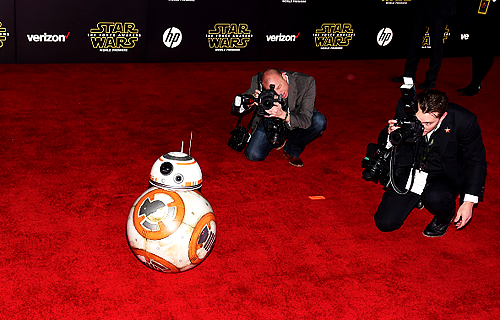
Still, though we all love and adore BB8, I think it’s only in the past few weeks leading up to its release that I realized quite how excited everyone was about things besides the adorable little droid. . My first clue was when I walked into my local Barnes and Noble to see it packed with Star Wars stuff. I mean, it usually has a lot of Star Wars stuff, because that space opera thing is popular, but this time it was like walking into a Lucasfilm storehouse. And if, years from now, fandom historians wonder, “what did the excitement around episode VII look like?” I’ll be able to say, like this:
In addition to merchandise, pretty much every magazine out there is publishing some sort of special or collector’s edition relating to the new movie:

(This sampling from Barnes and Noble is actually quite small). Of course, I couldn’t resist, so I went out and bought a bunch of “collector’s” editions of magazines. I don’t know how collectible they actually are, or whether they’ll be worth any kind of money a few decades down the line, but I”m the kind of person who buys anything apparently “collectible,” provided it’s geeky, hoping it’ll be worth something in the future. (Plus, I have a bunch of free subscriptions to magazines via targeted offers, so a bunch of issues came in the mail). Thus, I now have what I hope will one day be a collectible colletion of Star Wars themed magazines:

Still, it wouldn’t be a true geek milestone event without any kind of controversy, and of course it’s there. First, there’s the whole fiasco of John Boyega being cast as one of the protagonists, as white fans rose up against the “oppression” that casting a black character as a hero in the movies represented. Yes, I kid you not.
And then there’s Princess Leia. Luckily, we get to see Princess Leia come back for this movie, this time as General Leia and thankfully not in a bikini- rather significant, given Carrie Fisher’s comments about how hard it is for a woman in Hollywood over the age of 40 to get cast in anything (unless you’re Meryl Streep). Plus, there were JJ Abrams’ recent comments about how “Star Wars used to be something fathers took their sons to,” because apparently girls didn’t watch Star Wars until he came along to make the movies girl-friendly and pat himself in the back for it. (Which, by the way, is exactly what he said about Star Trek, despite the fact that Star Trek pretty much exists in any significant form today because of women, thank you very much).
So, with all of that history, and seeing all that merchandise in stores, I started thinking. A fascinating article was recently published called “Where the Fuck is Princess Leia?” point out the lack of Princess Leia in Star Wars merchandise. This is a trend that isn’t limited to Star Wars – in the Marvel fandom, Black Widow and Gamora figurines are pretty non-existence, they’re not on the posters, and they’re probably never going to get their own movies. It all has to do with gendered marketing: franchises like to market to a particular demographic (a particular gender, a particular age). Hence the lack of, say, Gamora.
But Star Wars has such universal appeal, you say. It’s something everybody watches. Just because girls watch Star Wars doesn’t mean they’ll stop watching “girly” things, I mean, Star Wars is one of those cult movies. It can’t hurt to make a few Princess Leia toys for the girls, right?
…apparently not. Wading through all the Star Wars merchandise pictured above, I found three Princess Leias. Yes, three. There were dozens and dozens of Darth Vaders, R2D2s, wookies, Yodas, Jedi, Han Solos…..but as for the ladies? Here’s what I found:
Yes, that’s it. Leia in a slave bikini (because if we’re going to make Princess Leia figurines, we should make sure to objectify her – though Carrie Fisher’s comments on the subject are a breath of fresh air), a Princess Leia that is part of a figurine pack, and a keychain. Well, I guess you could count the Leia on the clock, though that’s part of a poster.
And, looking through, for example, the standees offered by Barnes and Noble (which had a lot of Star Wars stuff, as pictured above), these were the offers:

I mean, there’s Daisy Ridley’s character, who is in the new Star Wars, but please note that of the above ten characters, one is a woman. the rest are male (or in the case of stormtroopers, we don’t really know their genders, but…)
Needless to say, I am both unsurprised and disappointed. I don’t collect a lot of merchandise or action figures and the like, and as a little girl, I was never really troubled by the lack of a Princess Leia figurine, because I had plenty of other female characters I admired, like Xena and Hermione Granger. Still, I think this says a lot about who we expect to be watching these movies, and who we expect to be fans of these movies – and The Powers That Be clearly still think that the people who are going to be geeky and fannish enough to buy merchandise are goings to be boys…or only care about the male characters.
So, with my expectations tempered by both JJ Abrams’ inane comments and my own exploration into the world of Star Wars merchandise, I can still say that I am incredibly excited for Episode VII, which comes out exactly 17 minutes from now as of this writing. 🙂
Chicago Stargate Convention 2015: Part 3
A little belatedly (and by a little I mean a lot), here’s a write-up of the last day of the con (in two parts).
Sunday started off with a panel with Rachel Luttrell and Paul McGillion, which Rainbow Sun Francks promptly joined (and refused to leave, not that anyone minded). This is the first time I’ve seen Rachel at a Stargate con in four years of going – she’s always had other commitments; I must admit, on my first watchthrough, I wasn’t a big fan of Teyla, though that’s changing slightly as I rewatch Atlantis. Still, I feel that with Teyla, there was a gap between what the writers intended intended (a strong woman and leader) and what actually happened (a character who consistently made badly thought-out decisions without foresight because the writers didn’t know what to do with a strong woman….which is a problem they strangely didn’t have with Weir). Partly due to this motivation, I asked Rachel, Paul, and Rainbow whether there was anything they’d chance about how their character had been written (besides dying, I added jokingly, as that’s something that happened to Ford and Beckett). Rainbow nonetheless said dying, but Rachel gave a more interesting answer: she talked about how interesting it was that Teyla came from what seemed like a matriarchal society, in which she was unquestionably a leader, and that there was a lot to explore about that kind of society and her role into it that the writers didn’t delve into as much as they could’ve. It’s an answer I agreed with – I’d have liked to see more of Teyla’s society, and more of her being a competent leader. In addition to this interesting answer, Rachel also graced us with some of her beautiful singing:
After that, I devoted much of the day to getting autographs with various celebrities who were offering them (and pointedly avoiding the Stargate novels panel) – quite a number of the celebrity guests were offering their autographs directly, which meant that I got to chat with them quite a bit, and in fact, have some mini-sagas to tell via autographs.
The first autograph I got was from Andee Frizzell – the Wraith Queen. Andee had been hanging around the hotel the entire weekend, interacting with guests, and we shared a fun moment when I walked out of the elevator to discover her and a bunch of people pointing confusedly at a thong lying on the floor. It was just there – no explanation, but a leopard-printed thong. I quickly snapped a picture of Andee making the most hilarious confused face as she pointed at it, though it’s a photo Andee would rather I not share (she gave me a lengthy talk about enjoying the con “in the moment” rather than spending it all snapping photos. I might disagree, but it’s a picture of her, so I’ll respect her wishes in the matter). In any case, the “thong saga” continued as I asked Andee to autograph my Stargate: Atlantis DVD set, on which I’m collecting the entire cast’s autographs. She wrote me a little message:
Later, I went to get Rainbow Sun Francks’ autograph (which required standing in line behind a gentleman who had made the most amazing Stargate replica). I asked him to sign the same DVD set, since he’s an Atlantis cast member, and the only season DVD in that set that had Rainbow on it was the same one Andee had signed – conveniently. So, of course, I recounted the whole saga to Rainbow so that he would understand why Andee was asking about her undies. Rainbow, of course, was amused, and totally went with it, penning this as his autograph (fun fact: he has the most neat, careful handwriting I’ve ever seen, but which also takes forever to write because it’s so neat and careful, so I swear, I stood there for five minutes waiting to get that autograph!):
I later stopped by Andee’s table again to show her the results of what she’d started and Rainbow’s contribution, which she found utterly hilarious. And who knows? Perhaps next year they’ll have another Atlantis celebrity guest who will sign that same DVD and wonder what’s going on with those undies.
But for the moment….I guess the secret is out. I left my undies in Rainbow’s room. And a few other things, too….
I also stopped by to get autographs from Suanne Braun (as I mentioned in a previous post) and Peter Williams. The two of them were doing their own “impromptu” photo op – you and your Goul’d overlords, because Creation isn’t very good at thinking of clever photo op combos – and of course I jumped on the opportunity to take a photo with two stunning, sexy deities (even though I had made one of them kneel the day before). We snapped a few photos, though I unphotogenically turned out terrible in all of them (although Suanne and Peter were pretty picky about how they turned out, which is why we snapped three – until Suanne and Peter were satisfied with how they looked, them photogenic people. I let it go. Me looking good in a photo isn’t going to happen).
I also had time over the three days of the con to stop by the vendors’ room extensively, spending more money than I probably should’ve. In my defense, I bought certain items that were of academic interest to me, which I can therefore justify as ‘research materials’ (to myself, at least) – for example, I bought a lot of concept art for Atlantis, as I’m working on some research on cities and spaceships in science-fiction, and thus studying the thought process behind the creation of Atlantis could be a useful resource.
But I also bought some more fun things, like some science-fiction prints for my collection of sci-fi art (of which I try to buy a piece at every convention I attend):
I also snagged a couple control crystals that were used on the set of Stargate as props, purchased from Stitch’s Loft- the same awesome people who had uniform replicas and concept art. Unfortunately David Hewlett wasn’t at the convention to sign one of them for me, but I’m keeping my fingers crossed that he’ll be at next year’s con so that Dr. Rodney McKay can sign one of my control crystals:
Then, it was time for the last couple panels of the day: Corin Nemec (with Cliff Simon, another con regular) and then Michael Shanks. I remember little from Corin’s panel, unfortunately, except that he was sweet and adorable. Michael’s panel was, of course, hilarious as always.
Michael Shanks is one of those actors that can evade questions like a politician while making you feel like he answered them, and simultaneously making everyone laugh so hard they’re crying (yes, it happened to me). Since Daniel Jackson is a really popular character who was around from the very beginning of SG-1, he’s obviously been doing cons and getting questions for a very long time – which means that he gets questions about miniscule details like “what was Daniel doing for the year he was ascended?” This led him to jokingly say “see, this is what happens when you have conventions for a show that’s been off the air for ten years!” Nonetheless, he answered the questions goodheartedly – even while fake-angrily asking “what am I, an expert on ascension?” when people wouldn’t stop asking him questions about ascension. And, of course, he used William Shatner’s trademark line of “you people need to get a life!” when it turned out that a good portion of the audience had seen Mega Snake, a TV movie that apparently was embarrassing enough that he doesn’t want to talk about it very much. (Of course, he meant it all goodheartedly, but his fake exasperation at some of the questions fans ask is just so much fun).
And that was the panels for the day! In my next, wrap-up, post I’ll talk about the photo ops I took that day, as well as some thoughts about actor-fan relationships in general.
Motor City Comic Con: The Belated Thoughts of an Aca-Fan
A few months ago (and by a few I mean almost a year, because it’s only now that I have time to finish up this piece), I had the good fortune of attending my local comic con: Motor City Comic Con. Even though it’s been some time, I felt the need to write up my thoughts and experiences, especially because this convention (and most comic cons in general, I’d guess) has been a completely different convention experience from any other I’ve had, and I wanted to explore what those differences might be – in terms of fan interactions, in terms of what it is that we look for at conventions, and in terms of what brings groups of people together at conventions like this. That is, this is a bit of a sociological post, with observations and thoughts on conventions as a form of social interaction.
The past conventions I’ve gone two have fallen into two types: they’ve either been centered around a particular franchise (Supernatural, Stargate, Star Trek), or more academic conventions (such as the World Science Fiction and Fantasy convention) full of panels and discussions rather than autographs and entertainers.
Conventions centered around a specific franchise (usually run by Creation Entertainment), are a very special experience: you crowd hundreds (sometimes thousands) of people all obsessed with the same thing into one hotel for three days, and every single star is from that franchise and has worked on it some way. Sure, many of them have been on other franchises and of course there’s overlap, but mostly everybody’s there for one particular fictional universe (as an example, I’ll use Stargate, since most of my experiences have been with that franchise).
The thing with conventions like this is that, crowded into a hall with hundreds of people who love the same stories and characters as you do, there’s an indescribable sense of connection and kinship. There’s jokes and quotes and trivia constantly exchanged. There’s a trivia contest for that particular show/set of shows. There’s arguments over which scientist is the most attractive one (Rodney McKay). There’s a costume contest focused on that series. And when you’re all crowded into a hall together, the venue starts playing the theme song from that show, an actor/actress comes out, and you all cheer together – it’s an amazing experience. There’s this sense of wild enthusiasm of being a part of something big, of just loving this show so damn much and being with a bunch of people who share that enthusiastic, almost spiritual love for this amazing show that damn well deserves this adoration. Honestly, my first convention was a bit of a spiritual experience. I had, in internet-speak, “feels” about loving Stargate so much and about so many people loving Stargate.
The other type of convention, the conference sort of convention, I go to a lot less; I’ve been to a small handful,, and presented at one. This really is like academic conference: there were literally hundreds of panels on different semi-academic topics, from the portrayal of aliens in sci-fi to violence and fantasy and the portrayal of gender. A lot of authors were on these panels, but so were academics, bloggers, and fans. Sure, there were autograph sessions with a few particularly well-known authors (such as George R.R. Martin), but the majority of the convention (at least in my experience), happened in these panels. Here, there wasn’t quite the same sense of “we all love the same thing so much.” Sure, a lot of us shared love for things like Star Wars and Firefly and could reference it, but rather than a sort of spiritual enthusiasm, it was a much more academic enthusiasm that was in these panels. It seemed to me to be a lot more about getting to the bottom of some very important questions, albeit in a fun way, than about love and adoration and enthusiasm.
And then there’s Comic Con type conventions, which, as I discovered, work totally differently from the other kinds of conventions I’ve been to.
This is what a comic con type convention looks like, in general:
It’s a great big hall, mostly full of vendors selling everything from comic books to action figures to autographed portraits. Inside this great big hall, there’s also booths for all of the celebrity, comic, and wrestling guests, who spend most of their time (when they’re not doing panels and photo ops) signing autographs at these booths. There’s also one photo op booth, with different stars doing photo ops at different times, and, outside the main hall, several smaller rooms where the biggest stars (in this case, William Shatner, John Barrowman, etc…) held hour-long panels (for these you have to line up way ahead of time and let me tell you, that is stressful). There’s also a handful of other attractions in this big hall, including costume displays, replicas (such as R2D2), cars (the Ghostbusters car, for example), and a number of organizations such as the 501st Legion who have tables/displays/demonstrations. It’s like a big huge geek museum with lots of stuff for sale and lots of celebrities.
As cool as this is, though, what it means is that this isn’t a convention focused on a particular franchise. There are stars from everything, from television to film, and writers and artists. Are you a fan of Wonder Woman and the Swamp Thing? There’ll be something for you there. Star Wars? Check. Any TV show from soap operas to Star Trek? Check. As someone who’s previously mostly attended conventions dedicated to a specific franchise – conventions where everyone there was united by their love for one specific thing – I found this plethora of different stars and interests incredibly disorienting. We were all here because we’re all geeks who lead a certain lifestyle, collect autographs, want to meet the people behind our favorite franchises, and make room in our life for our geekiness – but every single person there wasn’t connected by their huge and immense love for just one thing. There was no wave of love washing over the entire hall for just one thing. There was definitely something for everyone, but you had to dig through a little for it: going through many of the vendors, you had to search for the posters and figurines you wanted. When I was standing in line, interacting with, and talking to people, there was always that initial period of trying to figure out what they were fans of, looking for that connection. I usually found it – after all, if you’re in the same photo op line, chances are you have something in common, some fandom, some place to start talking and connecting. But there was no automatic connection or point of reference to the things you loved the most. Going from star to star to get autographs and photo ops, you constantly had to switch from franchise to franchise – one minute you’re flirting with John Barrowman and having Torchwood feelings, and the next you’re telling William Shatner how damn much you love Captain Kirk. The second you work up enthusiasm for one particular actor or character, you’re already getting ready to stand in line for something else, for a completely different franchise, which evokes in you a completely different set of feelings. Perhaps that’s a personal quirk of mine, but I found it utterly strange to switch from passion to passion like this.
And then, of course, the question remains: how do you connect? Conventions are, after all, a form of interaction, a way to meet fellow geeks, a way to be at home with people who understand you, but when it’s a hall crowded with thousands of people who might all love different things, how do you make connections? What’s the appeal of a convention like this when everybody’s so different, sometimes united by nothing more than their identity of being a geek? And certainly “geek” is an identity in itself – one I proudly wear, despite whatever the Big Bang Theory has to say; certainly the people at this convention were “my people,” the ones who got what it’s like to be obsessed with something, but it’s not quite the same as being at a Stargate convention.
One of the answers to that question, I suppose, is cosplay. I never really got cosplay before. I knew what it was, of course, and I’d half-heartedly donned a uniform of some sort in the past, but most of the Stargate and Star Trek conventions I’d gone to didn’t have too many cosplayers, and it’s not too hard to cosplay Supernatural unless you don’t own any plaid. But here, there were incredibly elaborate (and I mean really elaborate), detailed, and sometimes very huge and heavy costumes. I saw dozens of stormtroopers and Jedi, a Darth Vader, several incarnations of the Doctor, a handful of Daenerys Targaryens, a few Castiels (Supernatural), a handful of Starfleet officers, and dozens of other superheroes, robots, and steampunk costumes that I did not recognize. These people wander around, crowding the hall, checking out the vendors, getting autographs and photo ops, and it’s pretty amazing to be crowded by fictional characters like that.
But most amazing is the way that cosplay serves as a form of connection. My first day, I donned a Starfleet uniform (a science officer from the original series, carrying the rank of commander, which I suppose would make me a first officer as well). I had the costume made on Etsy, and invested a good portion of money in it. Coupled with some knee-high boots, if I do say so myself, I looked pretty believable – and I had several people come up to me and request to take photos with me, and a handful more compliment me on my outfit (including William Shatner!) My second day, I threw on some denim and plaid to cosplay Dean Winchester, and ran into a Gabriel and a few Castiels from Supernatural, whom I took photos with as well. This all seems unremarkable except when you realize that in a hall crowded with thousands of people obsessed with hundreds of different fictional worlds, cosplay becomes that sort of connection. It becomes a way of proclaiming “this is what I’m a fan of!” and finding like-minded people in a huge hall. Most of all, however, cosplay becomes a sort of identity, that lets you identify people who have similar identities and connect through that.
Speaking of identity – there’s a lot of academic though about how identity is all just performance (Goffman and Judith Butler both write about this quite a bit), and a number of academics in the field of fandom studies have started applying this kind of theorizing about identity to cosplay as well. It seems to make sense: after all, when you don a costume, you, to some extent, don a personality; you make some sort of claim about who you are and what character means enough to you to dress up as them. You express your identity through fiction by making that fiction into reality. Whether you want to call it mimesis or performance, you take a piece of something that’s inspired your imagination and you create a physical product that allows others to see who you are and to relate to that identity. And again, in a hall crowded with thousands of people, this ability to wear your identity on your sleeve – and to use that identity to connect with others by using a common, fictional reference point, is pretty handy and pretty fascinating.
Plus, have I mentioned how cool it is to wander a convention hall and run into fictional characters? A number of the costumes were so elaborate that it felt like Darth Vader was actually strolling through the hall or that a Stormtrooper was following you. Especially if their faces were hidden, it really felt like fiction came to life, in, say, the form of a group of Jedi on secret Jedi business. It was like a number of fictional worlds had all come to life at the same time, and all the fictional characters were dumped into one place to walk around. I can’t explain just how amazing and breathtaking it is to see all these fictional characters become real and just sort of…wander around, just like you do, buying stuff and talking to people. Part of the charm, I think, is not just cosplaying yourself, but in creating that atmosphere where the fictional worlds come to life for the people around you, who feel like the things they’re invested in exist, that they’re somehow real because look, there’s Jedi and stormtroopers walking around, so it clearly must be Tatooine.
Which leads me to my next point about what brings people to conventions. Why do people come if they don’t come for that kind of uniting love of one franchise? Of course, they come to take photos with stars and get autographs and buy stuff and ask questions. But I think all of this – as well as all the cosplay and all the fictional worlds coming to life – all hint at a deeper need. One that I think William Shatner hit upon pretty brilliantly in his panel: it’s a sort of ritual.
Shatner spoke of science fiction in itself as a sort of mythology. Normally, mythology attempts to explain how the world works – which is why there were gods of the sea and weather and fire and rain and whatnot, and Prometheus myths, and giants. Nowadays, we’ve explained the sun and the moon, but there are still mysteries in the universe – so much we don’t know. What’s out there? How much don’t we know about what we don’t know? Science fiction, to some extent, fulfills that mythological need – it attempts to explain what might be out there, gives us ideas and possibilities, and makes us think about them. It doesn’t always provide answers, but it does provide perspectives. Star Trek was particularly great at this, taking us to other planets and other cultures and helping us to understand what might be out there and how the universe might work. And conventions are – well, responses to that sort of mythology. They’re a way for us to find answers and enchantment in a more modern world, where science and reason play a role in that mythmaking but where there’s still wonder.
And indeed, there seems to be a form of ritual about these conventions, where people are brought together by this sort of modern mythology in ways that are, in some ways, ritualized.
In a book on audiences and performance, two authors (Abercrombie and Longhurst) point out the ritual, almost sacred nature that is involved in being a “simple” audience – that is, in attending the theatre, or a concert, where there are certain unspoken rules of etiquette, certain actions that are always followed, certain scripts according to which the audience behaves, which gives the entire endeavor a sort of ritualized, and therefore sacred, experience. They also point out the way that theatre was often tied to the sacred in the past – from the theatre of ancient Greece to the medieval church plays – and indeed, I agree with them that there is something ritualized and sacred about going to the theatre, about going to see a performance – or about going to see a panel and interacting with an actor or artist as one would in a theatre.
I think this form of the sacred, and of ritual, extends much further, though. Without going too academic on all of this, I think there’s an element of seeking out the sacred in collecting autographs or comics our figurines (artifacts, really), a certain element of ritual in the way that encounters with stars happen (photo op and autograph etiquette is usually the same at every convention, and there are certain very strict rules in how you can approach and interact with someone, who’s placed on a pedestal by virtue of being a celebrity). These celebrities, rather than being representatives of a religion, are to some extent representatives of a mythology – the mythology of science fiction, of comics, of geekdom, that William Shatner talked about – and our interactions with these people are highly controlled, highly ritualized because of it (you can do this, you can’t do that), which gives it all a character of the almost sacred (“William Shatner signed my Enterprise! John Barrowman touched my butt!” kind of sounds like “this saint laid his hands on me!”)
So I think, inadvertently, Mr. William Shatner hit upon something that it might behoove academics of fandom and of popular culture to study – the way that science fiction, popular culture, and geekdom, are a form of mythology and a form of the sacred in our modern day culture, and the way that conventions are not only a manifestation of “worship” (in a loose sense of the word) of the sacred, but also the way that people connect through their investment in this mythology (for, like it or not, religion has to a certain extent often been a way for people to connect, even as it’s been the source of religious wars and sects).
And that finishes up my post as an aca-fan, as a geek who’s also an academic, who enjoys reveling in the wonder of meeting Captain Kirk but who also likes to think about the processes involved in this interaction.
















